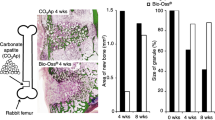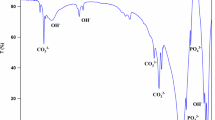Abstract
Abstract
To develop synthesized coralline hydroxyl apatite (CHA) bone graft-substitute and measure its physical and chemical characteristics.
Methods
The CHA bone graft-substitute was synthesized from natural mineral—coralline through hydrothermal exchange process. This process was designed and developed independently by the authors. Its physical and chemical characteristics have been determined and studied using various techniques including Scanning Electron Microscopy (SEM), electron microscope image processing, scanning electron microscope energy spectrography; chemical analysis, ICP-AES, X-ray diffraction, etc. Clinical trials have been conducted.
Results
Independently developed CHA bone graft-substitute is white in color; its porosity is 25.87%–53.58%, which is approximate to that of human bones and original coral. It is larger than 3–4 in hardness by Mohs hardness scale and the compressive strength ranges from 4.87 to 12.31 MPa. The chemical compositions of the CHA are 53.13%–64.09% CaO and 35.52%–46.48% P2O5. CaO/P2O5 is 1.143–1.804. ICP-AES analysis detected twenty-four trace elements including Pb, Co, Ni, Ba, Mn, Cr, Th, V, Cu, Ti, K, Mo, Zn, Mg, Nb, Be, Sc, Al, Sr, Na, Li, etc. Ca, P, K, Na, Al and Sr are relatively high while the rest are less than n−n×10−6, which is acceptable by human body. The REE level in the CHA bone measured by ICP-MS is 1.433×10−9–2.212×10−9, which is within the acceptable range for human beings.
Conclusions
The process of synthesized CHA bone graft-substitute is an innovated independently developed method and concept. Its color, porosity and chemical composition are similar to those of human bones; therefore it has very good biocompatibility and excellent conductivity. Sixty clinical cases have proved that CHA bone graft-substitute has a strong bone-forming ability, no toxicity, no side effect, and better sacralization. It is a fine substitute for bone transplantation.
Similar content being viewed by others
References
Chen Guoxi and Zhang Yuepeng (1989) Phase Transition Pattern Manual of Thermal Analysis and Powder Crystal Analysis of Minerals [M]. pp.335. Sichuan Science and Technology Press, Chengdu (in Chinese).
Chiaki Igarashi, Naotatsu Shikazono, and Haruhiro Otani (2007) Geochemical behavior of rare-earth elements and other major and minor elements in sound-producing and silent beach sands in Japan [J]. Chinese Journal of Geochemistry. 26, 35–45.
Della M. Roy and Sari Kurtossy Linnehan (1974) Hydroxyapatite formed from coral skeletal carbonate by hydrothermal exchange [J]. Nature. 247, 220–222.
Quan Ri, Zhang Yu, Yin Qingshui, Li Zhaolin, Li Wen, Zhang Hongbin, Zhan Chunli, Chen Bingxu, Xu Chun, and Hu Xudong (2003) An in vivo experiment study of bone fusion with combined coralline hydroxyapatite graft material in bone defect animal model [J]. Chinese Journal of Orthopaedic Trauma. 5, 257–258 (in Chinese with English abstract).
Yin Qingshui, Zhang Huimin, Su Zenggui, Zhao Jun, Lai Riquan, Zhou Minwei, Xie Yuhui, Li Zhonghua, Zhong Shizhen, and Wei Zheng (1996) Experimental study of repairing of a segmental diaphseal defect with coralline hydroxyl apatite (CHA) as bone graft substitute [J]. Chinese Journal of Orthopedics. 16, 726–731 (in Chinese with English abstract).
Yin Qingshui, Zhang Yu, Li Zhaolin, Xu Guozhou, Xia Hong, Huang Huayang, and Quan Ri (2003) Preparation of the composite rhBMP-2/CHA bone graft substitutes and clinical application [J]. The Journal of Bone and Joint Injury. 18, 147–149 (in Chinese with English abstract).
Zhang Yu, Yin Qingshui, Li Zhaolin, Huang Huayang, Xu Guozhou, Li Wen, Xia Hong, and Quan Ri (2004) Initial report on application of compounded bone graft substitute in infection caused bone defection [J]. The Journal of Bone and Joint Injury. 19, 185–186 (in Chinese).
Zhang Yu, Yin Qingshui, Pan Gangming, Zhang Hongbin, Zhan Chunli, Chen Bingxu, Xu Chun, Hu Xudong, and Li Zhaolin (2002) A evaluation of anterior cervical interbody fusions with combined hydroxyapatite graft material [J]. Guangdong Medical Journal. 23, 907–908 (in Chinese with English abstract).
Author information
Authors and Affiliations
Corresponding author
Rights and permissions
About this article
Cite this article
Li, Z., Li, W., Bo, Z. et al. Study on the physical properties and chemical compositions of artificially synthesized coral hydroxyl apatite (CHA) bone. Chin. J. Geochem. 28, 421–426 (2009). https://doi.org/10.1007/s11631-009-0421-2
Received:
Accepted:
Published:
Issue Date:
DOI: https://doi.org/10.1007/s11631-009-0421-2




